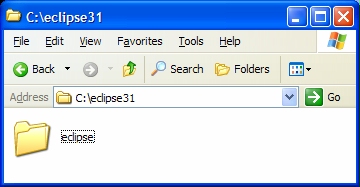
These notes show how to install the new version 3.1 which supports Java 5, set up a desktop shortcut for running Eclipse, and creating an Eclipse workspace.
NOTE: These tutorial were done using Eclipse version 3.1
NOTE: In these tutorials we install Eclipse, workspaces and other
files related to the tutorials in a directory called
c:\eclipse31. If you are using another directory such
as your home directory
c:\Documents and Settings\username\eclipse31
you will need to replace c:\eclipse31
everywhere with your directory.
NOTE: Omit this section if you are working in the lab.
NOTE: Omit this section if you do not have any version of Eclipse installed.
If you have version 3.0 or earlier just move your entire eclipse directory (eclipse30 for example) and workspaces to
some other directory (eclipse-old for example)
and delete the desktop shortcut.
If you need any of your projects you can always import them into
version 3.1 later.
NOTE: Omit this section if you are working in the lab.
NOTE: Before installing eclipse it is necessary to have Java 5 and its documentation installed (see Java installation.)
At the time of writing
the current eclipse distribution is 3.1 and it comes in the zip file
eclipse-SDK-3.1-win32.zip.
If you use WinZip them unzip this distribution file
and specify c:\eclipse3.1 as the
directory to unzip into.
If you are using the Win XP zip facility then make the
directory c:\eclipse31 first and then unzip
the distribution file into it.
In either case you should now have a directory
c:\eclipse31 containing the eclipse
directory that looks like

NOTE: Omit this section if you are working in the lab.
Open the eclipse directory and you will see
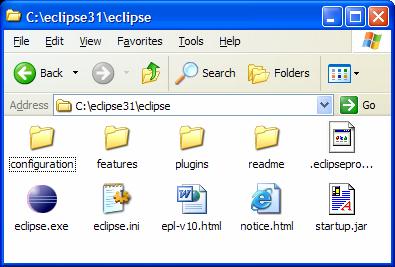
The file eclipse.exe is used to run eclipse.
Make a shortcut to this file on the desktop by right clicking
on the eclipse.exe icon, seleting "Send To"
and selecting "Desktop (create shortcut)". Then rename the
shortcut to eclipse31.
If you are working in the Linux lab you can find the Eclipse icon on one of the program menus (ask a lab advisor if you can't find it).
On your home PC run Eclipse by double clicking the shortcut you made.
PC NOTE: In this section we assume you are creating a workspace
on drive C: on your home PC.
LINUX NOTE: On Linux when you run Eclipse you can simply accept the default workspace in your home directory that Eclipse shows you when you run it.
When you run Eclipse you will see the following dialog box asking for a workspace name. A workspace is a folder (directory) that is used to store projects (Java projects in our case) that are related to each other.
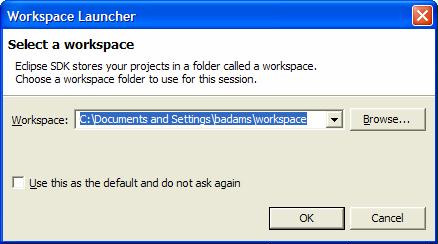
The default directory shown is your home directory.
If you want your directories to match the Eclipse tutorials don't use this directory path. Instead use the workspace
c:\eclipse31\e-workspaces\workspace
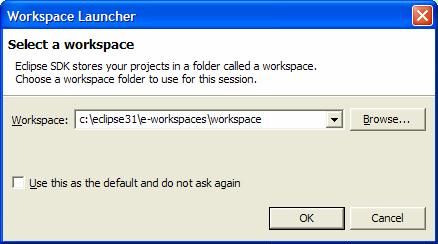
This is convenient since it puts everything (eclipse and its workspaces)
inside the one directory c:\eclipse31.
The e-workspaces directory can be used to contain several
workspaces although you will only need the one
called workspace for our course.
If you really want to use multiple workspaces in your home directory use something like
c:\Documents and Settings\YOURNAME\e-workspaces\workspace
[Note: In the following tutorials you will learn how to use Eclipse, configure it and set preferences. If you want to use more than one workspace and have them configured in the same way you will have to configure new workspaces and set the preferences again unless you learn how to export the preferences of one workspace and import them into another. Therefore for our course it is easiest to just use one workspace.]
Eclipse will now use your choice as the default workspace unless you specifiy another name when you run Eclipse again.When you have specified a workspace click OK to see the the initial eclipse IDE wecome window.
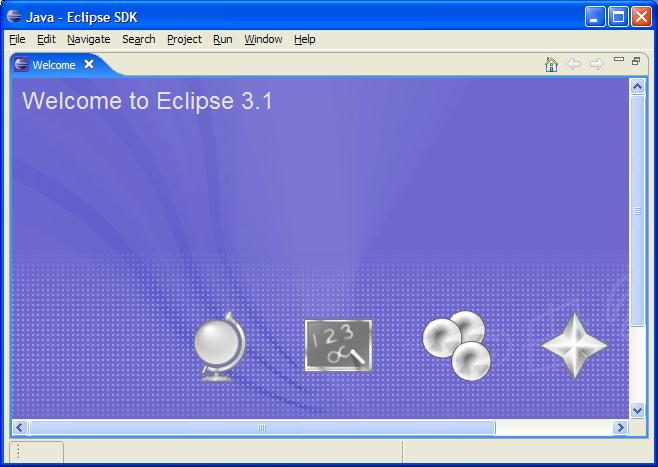
For now just close Eclipse. If you look at the eclipse31
directory you will see the following structure

The eclipse directory contains the eclipse system and
the e-workspaces directory contains our workspaces:
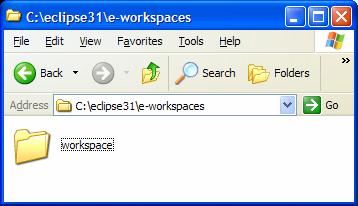
There is one workspace here in subdirectory workspace.
Now try the introductory Eclipse tutorial which shows how to create Java projects, packages, and classes and run them.